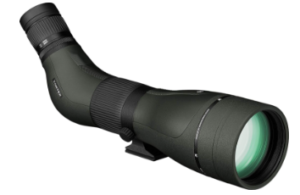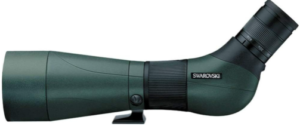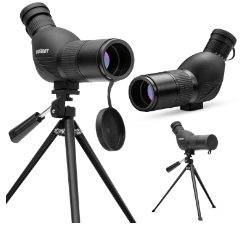Discover a new level of clarity and convenience in your bird-watching adventures with the Best Compact Spotting Scope for Birding. These handy optics are perfect for bird watchers who crave portability without compromising on performance.
Don’t miss out on these top picks – click on them to discover the perfect compact spotting scope for your birding adventures!
| 1) Vortex Diamondback HD 20-60x85mm Spotting Scopes |  |
|
| 2) Vortex Razor HD 27-60×85 Spotting Scope |  |
|
| 3) Swarovski ATS-65 HD 20-60x65mm Spotting Scope |  |
|
| 4) Roxant Blackbird Spotting Scope – 12-36×50 |  |
Are Spotting Scopes Good for Bird Watching?
Yes, spotting scopes are excellent for bird-watching. They offer high magnification, therefore allowing you to see birds in detail even at a distance.
Spotting scopes also have better light-gathering capabilities than binoculars, making them ideal for observing birds in low-light conditions or at dawn and dusk. Their longer focal length provides a narrower field of view compared to binoculars, but this can be advantageous for focusing on specific birds or details.
What is The Best Magnification for Bird Watching?
A magnification range of 20x to 60x is generally recommended for bird watching with a spotting scope.
- 20x to 30x: Lower magnifications offer a wider field of view, making it easier to locate and track birds, especially in dense foliage or when birds are in flight. Lower magnifications also provide a brighter image and are less affected by atmospheric conditions such as heat shimmer.
- 40x to 60x: Higher magnifications allow you to see birds in greater detail, making them ideal for observing small or distant birds. However, higher magnifications require more stable mounting, such as a tripod, to prevent image shake.
Is a Spotting Scope Better than a Telescope for Birding?
Both spotting scopes and telescopes have their advantages and disadvantages for birding, and the choice between them depends on your specific needs and preferences:
Spotting Scope:
Advantages
- Designed for terrestrial viewing, providing correct image orientation.
- Typically lighter and more portable than telescopes.
- Generally more affordable than telescopes of similar optical quality.
- Offer a wider field of view, making it easier to locate and track birds.
- Often have zoom eyepieces, allowing for variable magnification.
Disadvantages
- Limited to lower magnifications compared to telescopes.
- May not offer the same level of image clarity and brightness as telescopes, especially at higher magnifications.
Telescope:
Advantages
- Can achieve much higher magnifications than spotting scopes, ideal for observing distant or small birds in detail.
- Generally have larger objective lenses, providing brighter and clearer images, especially in low-light conditions.
Disadvantages
- Typically heavier and bulkier than spotting scopes, making them less portable.
- Require additional equipment, such as star diagonals, to provide correct image orientation for terrestrial viewing.
- Higher quality telescopes can be more expensive than spotting scopes.
Best Compact Spotting Scope for Birding
1) Vortex Diamondback HD 20-60x85mm Spotting Scopes

The Vortex Diamondback HD 20-60x85mm Spotting Scope is a high-performance optic designed for spotting wildlife, birding, hunting, and target shooting.
Featuring a large 85mm objective lens with high-density, extra-low dispersion glass, it delivers exceptional clarity, resolution, and color fidelity, even in low-light conditions.
With 20-60x magnification range allows for detailed observation of distant subjects, thus making it ideal for long-range viewing.
Built to withstand harsh outdoor conditions, it is housed in a rugged, rubber-armored magnesium alloy body that is both lightweight and durable. It is nitrogen-filled and O-ring sealed, making it waterproof, fog-proof, and shockproof, ensuring reliable performance in any environment.
For easy and precise focusing, it is equipped with a dual-focus mechanism, thus allowing for quick adjustments to both the coarse and fine focus. The twist-up eyecup provides comfortable viewing for eyeglass wearers, while the included adjustable eyepiece can be customized to the user’s preference.
Key Features
- Magnification: 20-60x
- Objective Lens Diameter: 85mm
- Field of View: 101-50 feet/1000 yards
- Close Focus: 22 feet
- Eye Relief: 20-16.5mm
- Exit Pupil: 4.25-1.42mm
- Length: 15.5 inches
- Weight: 76.6 ounces
- Waterproof and fog-proof: Yes
- Prism Type: Porro
- Optical Coatings: Fully multi-coated
- Tripod Adaptable: Yes
- ArmorTek: Yes
- Sunshade: Built-in
Pros
- Has Dual Focus
- The scope comes with useful accessories such as an eyepiece cap, objective lens cover, and a custom-fitted case.
- Weatherproof
- Versatile use
Cons
- It is priced higher than some other spotting scopes in its class, which may be a drawback for budget-conscious buyers.
2) Vortex Razor HD 27-60×85 Spotting Scope

The Vortex Razor HD 27-60×85 Spotting Scope is a top-of-the-line optic designed for serious enthusiasts and professionals in various fields such as wildlife observation, birding, hunting, and target shooting.
It features a high magnification range of 27-60x, thus allowing for detailed observation of distant subjects, making it ideal for long-range viewing.
A large 85mm objective lens with high-density, extra-low dispersion glass that delivers exceptional clarity, resolution, and color fidelity, even in low-light conditions, ensuring a superior viewing experience.
It is nitrogen-filled and O-ring sealed, thus making it waterproof, fog-proof, and shockproof, ensuring reliable performance in any environment. Also features a rotating tripod ring that allows for customizable viewing angles and a built-in sunshade to reduce glare in bright conditions.
Key Features
- Magnification: 27-60x
- Objective Lens Diameter: 85mm
- Field of View: 117-68 feet/1000 yards
- Close Focus: 16.4 feet
- Eye Relief: 17-16.7mm
- Exit Pupil: 3.1-1.4mm
- Length: 15.5 inches
- Weight: 65.6 ounces
- Waterproof and fog-proof: Yes
- Prism Type: Porro
- Optical Coatings: Fully multi-coated
- Tripod Adaptable: Yes
- ArmorTek: Yes
Pros
- Has a dual focus
- Good quality
- Versatile magnification range
Cons
- At 65.6 ounces, the Razor HD is relatively heavy, which may be a consideration for users prioritizing portability.
3) Swarovski ATS-65 HD 20-60x65mm Spotting Scope

The Swarovski ATS-65 HD 20-60x65mm Spotting Scope is a high-quality optical instrument designed for birdwatching, nature observation, and target shooting.
Its compact and lightweight design is ideal for users who need a portable and versatile optic for outdoor activities.
Features a 65mm objective lens with high-definition glass, which provides exceptional clarity and resolution, even in low-light conditions. The 20-60x magnification range allows for detailed observation of distant objects, making it suitable for both wide-field scanning and close-up viewing.
To withstand the rigors of outdoor use, has a rugged magnesium housing that is waterproof and fog-proof. This makes it suitable for use in various weather conditions, ensuring reliable performance in the field.
It is equipped with a dual-focus mechanism, thus allowing for quick adjustments to both the coarse and fine focus. The scope also features a rotating tripod ring that allows for customizable viewing angles and a built-in sunshade to reduce glare in bright conditions.
Key Features
- Magnification: 20-60x
- Objective Lens Diameter: 65mm
- Field of View: 108-60 feet/1000 yards
- Close Focus: 16.4 feet
- Eye Relief: 17mm
- Exit Pupil: 3.3-1.1mm
- Length: 14.6 inches
- Weight: 48.4 ounces
- Waterproof and fog-proof: Yes
- Prism Type: Roof
- Optical Coatings: Fully multi-coated
Pros
- Build with quality
- Compact and Lightweight
- Has Dual Focus
- Has Accessories
Cons
- The field of view at 20x magnification (108 feet/1000 yards) is relatively narrow compared to some other spotting scopes.
4) Roxant Blackbird Spotting Scope – 12-36×50

The Roxant Blackbird Spotting Scope is a compact and versatile optic designed for outdoor enthusiasts, bird watchers, hunters, and target shooters.
With a magnification range of 12-36x and a 50mm objective lens, it offers a balance of magnification and light-gathering capability, making it suitable for a variety of viewing situations.
It features fully multi-coated optics, which help to maximize light transmission and enhance image clarity and brightness. This ensures that users can enjoy crisp and clear views of distant objects, whether they’re observing wildlife, birds, or targets at the range.
Has a compact and lightweight design, thus making it easy to carry and transport. This makes it a great option for users who are on the move or who want a portable optic that they can easily take with them on their outdoor adventures.
Key Features
- Magnification: 12-36x
- Objective Lens Diameter: 50mm
- Field of View: 150-75 feet/1000 yards
- Close Focus: 10 feet
- Eye Relief: 14-12mm
- Exit Pupil: 4.2-1.4mm
- Length: Not specified
- Weight: Not specified
- Waterproof and fog-proof: Not specified
- Prism Type: Not specified
- Optical Coatings: Fully multi-coated
Pros
- Its affordable
- Has a compact size
- Includes Accessories
- Zoom Range: The 12-36x magnification range allows for a wide range of viewing distances.
Cons
- None
Factors To Consider When Choosing The Best Compact Spotting Scope for Birding
When choosing the best compact spotting scope for birding, consider the following factors:
- Magnification: Opt for a spotting scope with a magnification range suitable for birding, typically around 20-60x. Higher magnifications allow you to see birds more clearly at a distance but may require a stable tripod for steady viewing.
- Objective Lens Size: A larger objective lens (around 60-80mm) can gather more light, thus providing brighter and clearer images, especially in low-light conditions. However, larger lenses can make the scope heavier and less compact.
- Size and Weight: Compact spotting scopes are easier to carry and handle in the field. Choose a balance between size, weight, and performance that suits your needs.
- Optical Quality: Look for spotting scopes with high-quality optics, including fully multi-coated lenses and prisms, for sharp, clear, and color-accurate images.
- Waterproof and Fogproof: Choose a spotting scope that is waterproof and fogproof to withstand various weather conditions and environments.
- Close Focus: A shorter minimum focusing distance allows you to observe nearby birds with clarity and detail.
- Eye Relief and Eyepiece: Consider the eye relief, especially if you wear glasses, and choose an eyepiece design that provides comfortable viewing for extended periods.
- Durability: Look for a spotting scope made from durable materials that can withstand outdoor use and occasional bumps or drops.
- Accessories: Check if the spotting scope comes with essential accessories like a tripod, carrying case, lens covers, and cleaning tools.
- Price: Set a budget based on your needs and the features you prioritize, balancing performance and affordability.
FAQS
- Are compact spotting scopes suitable for birding?
Yes, compact spotting scopes can be suitable for birding, especially if you value portability and ease of use. Look for a compact spotting scope with a balance of size, weight, and performance that meets your birding needs.
- Do I need a tripod for a compact spotting scope?
While a tripod is not always necessary for a compact spotting scope, it can greatly improve stability and ease of use, especially at higher magnifications. Consider a lightweight and portable tripod for birding.
- What is the difference between angled and straight spotting scopes?
Angled spotting scopes have an angled eyepiece, which can be more comfortable for viewing birds in trees or at different angles without adjusting the tripod height.
Straight spotting scopes are more intuitive for beginners and may be easier to use for viewing birds on the ground or at eye level.
Final Thoughts
Finding the best compact spotting scope for birding can truly transform your outdoor experience. Whether you’re exploring new habitats or simply enjoying the beauty of birds in your backyard, a high-quality spotting scope can bring you closer to nature in ways you never thought possible.
Related
- 6 Best Vortex Spotting Scope For Elk Hunting
- 7 Best Vortex Spotting Scope for Hunting
- 7 Best Vortex Spotting Scope for The Money

